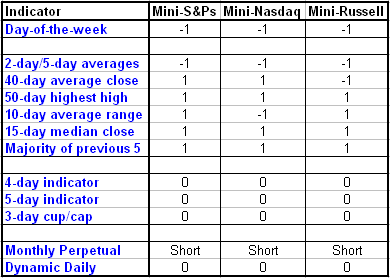We're finding ourselves at the wrong end of contrary signals that get more insistent the further the market moves against us. (Our daily signals keep flashing sells because the biggestâ€"in this case onlyâ€"moves for the week are up and the indicators are fade-oriented.) My partner and I have committed money over the years to several ideas like this. They work fine as the market does its normal back and forth oscillation. As it breaks out in one direction, however, we often find ourselves on the wrong side because again, as the market gets more adverse, the contrarian signal gets more insistent. What do you do at that pointâ€"throw in the towel and say, “Ok, if you can't beat them join them?” And buy on the mountaintop or sell in the valley?
It's all like a big Rubik's cube. Make five sides fitâ€"the sixth hurts you.
This sort of problem resulted in a rather amusing exchange years ago when we were pitching Howard Malman on the idea of managing a proprietary account for him. Howard is a very successful trader who appeared in my book When Supertraders Meet Kryptonite. He asked how big a loss we could theoretically take on a given trade. My partner cleared his throat and said, "Well, since the signals are contrarian in nature, they get more persistent as the market moves ever more against us. We have taken heat to the tune of 150 S&P points or more.”
To which Howard, again, very adept at profiting off his instincts, practically jumped out of his chair: “It takes you 150 points to know you're wrong!?”
Which totally sums up the difference between the discretionary and the mechanical approach. For the strictly mechanical trader, the market ain't talkingâ€"not at the inception of the trade, not at 100 points against us or in our favor. Only the signalsâ€"derived from historical researchâ€"have anything at all to say at all, namely “stick with the plan.”
The Biases
Hold all three index shorts.
The bottom two rows determine the signal. Dynamic Day One trumps everythingâ€"you always follow it. When it's neutral, the Monthly Perpetual provides the direction. Click here for a more in-depth explanation of the rules.

DISCLAIMER: It should not be assumed that the methods, techniques, or indicators presented on in this column will be profitable or that they will not result in losses. Past results are not necessarily indicative of future results. Examples presented on this column are for educational purposes only. These set-ups are not solicitations of any order to buy or sell. The author, Tiger Shark Publishing LLC, and all affiliates assume no responsibility for your trading results. There is a high degree of risk in trading.
Art Collins is the author of Market Beaters, a collection of interviews with renowned mechanical traders. He is currently working on a second volume. E-mail Art at artcollins@ameritech.net.